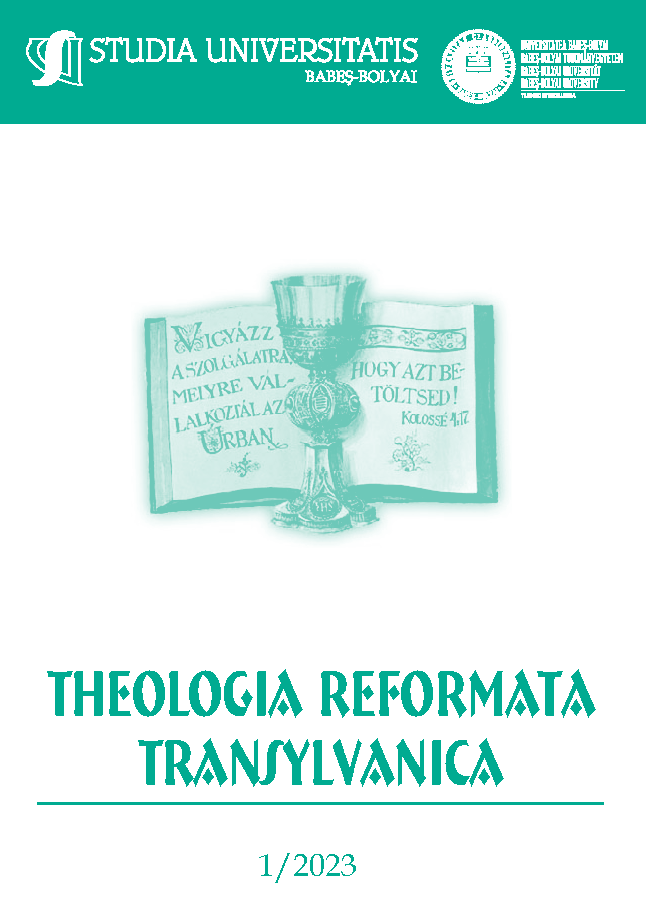Heidegger Pál apostol olvasata
DOI:
https://doi.org/10.24193/subbtref.68.1.05Keywords:
eschatology, phenomenology, letters of Paul, eidetic experience, theologyAbstract
Heidegger’s Reading of Apostle Paul. From 1915 to 1923, Heidegger taught in Freiburg. This was a delicate biographical and important philosophical phase for Heidegger, in which it became increasingly urgent to distance himself definitively from Husserl’s phenomenology. His attempt had developed into a theoretical orientation focused exclusively on the process of eidetic categorization of experience. The subject of his lectures in the academic year 1920/1921 was religion. In these lectures, he (also) dealt with the letters of Paul, which – until then – had been studied mostly by theologians. For this reason, Heidegger’s reading of Paul must be understood as a counterpoint against the background of the theology of the early twentieth century. Thus, Heidegger’s approach to Paul’s letters is primarily phenomenological. At the centre of his interest, there is the (re)discovery and analysis of the concept of eschatology. When Heidegger’s interpretation of eschatology is confronted with the history of eschatology, the true novelty of his approach emerges.
References
AGAMBEN, Giorgio (2005): The Time That Remains. A Commentary on the Letter to the Romans. Ford. Patricia Dailey. Stanford (California), Stanford University Press.
BARTH, Karl (1926): Der Römerbrief. München, Kaiser Verlag. xvi–xvii.
BLANTON, Ward (2007): Displacing Christian Origins. The University of Chicago Press.
BREJDAK, Jaromir (2010): Philosophia Crucis: The Influence of Paul on Heidegger’s Phenomenology. In: McGrath, S. J. – Wierciński, Andrzej (szerk.): A Companion to Heidegger’s Phenomenology of Religious Life. New York, Rodopi. 207–218.
BULTMANN, Rudolf (1958): Jesus Christ and Mythology. New York, Charles Scribner’s Sons.
DALEY, Brian E. (1991): The Hope of the Early Church: A Handbook of Patristic Eschatology. Cambridge, Cambridge University Press.
DE VITIIS, P. (2008): Heidegger e la philosophia crucis, In: Archivio di filosofia. 76. 1–2. 359–367.
DELAHAYE, Ezra (2013): Re-enacting Paul. On the Theological Background of Heidegger’s Philosophical Reading of the Letters of Paul, In: International Journal of Philosophy and Theology. 74. 1. 2–17.
DODD, Charles H. (1935): The Parables of the Kingdom. Nisbet.
GREISCH, Jean (2010): Heidegger’s Methodological Principles for Understanding Religious Phenomena. In: McGrath, S. J. – Wierciński, Andrzej (szerk.): A Companion to Heidegger’s Phenomenology of Religious Life. New York, Rodopi. 135–148.
HEIDEGGER, Martin (1991): Útban a nyelvhez. Budapest, Helikon (szerk. Zirkuli Péter – Márton László).
(2001): A fenomenológia alapproblémái. Ford. Demkó Sándor. Budapest, Osiris. 155–195.
(2003): Ființă și Timp. Ford. Gabriel Liiceanu – Cătălin Cioabă. Bukarest, Humanitas.
(2004): The Phenomenology of Religious Life. Ford. Matthias Fritsch – Jennifer Anna Gosetti-Ferencei. Bloomington, Indiana University Press.
HOMÉROSZ (é. n.): Iliász VIII. ll. 83–86, VIII. ll. 326–330.
HORST, Balz (1997): Early Christian Faith as Hope against Hope, In: Horst, Balz: Eschatology in the Bible and in Jewish and Christian Tradition. Sheffield, Sheffield Academic Press. 31–48.
KALARY, Thomas ((2012): Heidegger’s Aristotle Interpretation of 1922 and Its Significance for His Fundamental Ontology, In: Heidegger Studies. 28. 169–189.
KRISTEVA, J. (2009): This Incredible Need to Believe. New York, Columbia University Press.
KÜMMEL, Werner Georg (1954): Promise and Fulfilment. London, SCM.
LINK, Christian (1998): Points of Departure for a Christian Eschatology, In: Reventlow, Henning Graf (szerk.): Eschatology in the Bible and in Jewish and Christian Tradition. Sheffield, Sheffield Academic Press. 98–110.
MALHERBE, Abraham J. (2000): The Letters to the Thessalonians. Yale University Press.
MAZZARELLA, Eugenio (2020): Élet és lét. A heideggeri Seinsfrage kettős kezdete, In. Bollettino Filosofico. 35. 103–124.
MORA, Francesca (2020): La vita fattiva nel esperienza del protocristianesimo, In: Bollettino Filosofico. 35. 213–226.
NICHOLSON, Graeme (2010): The End of Time: Temporality in Paul’s Letters to the Thessalonians, In: McGrath, S. J. – Wierciński, Andrzej (szerk.): A Companion to Heidegger’s Phenomenology of Religious Life. New York, Rodopi. 219–231.
O’CALLAGHAN, Paul (2011): Christ Our Hope: An Introduction to Eschatology. Washington D.C., The Catholic University of American Press.
PLANTINGA, Richard J. (szerk.): An Introduction to Christian Theology. Cambridge, Cambridge University Press.
PLATO (1926): Laws (1–6). Loeb Classical Library Cambridge, MA: Harvard University Press.
SCHLEIERMACHER, Friedrich (2003): Der Christliche Glaube. Princeton Theological Seminary Library (https://archive.org/details/derchristlichegl12schl; utolsó letöltési dátum: 2023. január 14.).
SCHWEITZER, Albert (2005): The Quest of the Historical Jesus. A Critical Study of Its Progress from Reimarus to Wrede. Ford. W. Montgomery. Mineola (New York), Dover Publications.
SHEW, M. (2013): The Kairos of Philosophy, In: Journal of Speculative Philosophy. 27. 1. 47–66.
SURACE, Valentina (2020): Inquietus sum Sulle tracce luterane della decostruzione heideggeriana del soggetto, In. Bollettino Filosofico. 35. 234–247.
SZENT BIBLIA (2018). Károli Gáspár fordítása.
VAN BUREN, John (1994): Reading Heidegger from the Start. Albany, State University of New York Press.
WEISS, Johannes (1901): Die Idee des Reiches Gottes. Walter De Gruyter.
(2005) [1971]: Jesus’ Proclamation of the Kingdom of God. Philadelphia, Fortress Press.
Downloads
Published
How to Cite
Issue
Section
License
Copyright (c) 2023 Studia Universitatis Babeș-Bolyai Theologia Reformata Transylvanica

This work is licensed under a Creative Commons Attribution-NonCommercial-NoDerivatives 4.0 International License.






